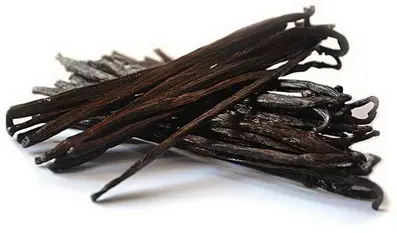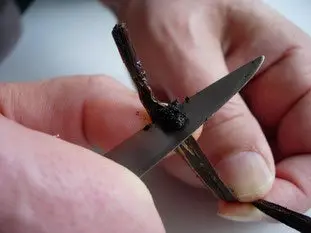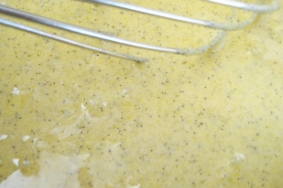This site uses only a few technical cookies necessary for its operation. By continuing to browse, you accept their use.
To find out more...
To find out more...
There is vanilla and vanilla

The vanilla is a delicious taste that can be found in many many dessert recipes, creams (the cream and the cream for example), ice creams, but also cakes and entremets.
Whenever you need to add this vanilla note, you have several possible choices because vanilla is commercially available in different forms, and also price...
Whenever you need to add this vanilla note, you have several possible choices because vanilla is commercially available in different forms, and also price...
13 K 5/5 (14 reviews)
Last modified on: December 14th 2017
There is vanilla and vanilla
We could try to make a mini-inventory of the possibilities, and of the associated quality, but to make it simple, there are 2 forms of vanilla: the pods, and the rest.
And the vanilla bean is the best: you are sure of what you are handling, it is impossible to make fake vanilla beans (well... for the moment). A vanilla bean is the fruit of the vanilla tree that has been dried and prepared. It doesn't smell much like vanilla, because its secret is inside, the little black, pasty beans that are the value of vanilla. To use a pod, you split it in 2 lengthwise and scrape out, with the back of a knife, the small black grains it contains and add them to your preparation.
It's the presence of those little black seeds that are your assurance that you're dealing with something that actually contains real vanilla.
There are different varieties of vanilla beans, depending on their origin, Indian Ocean, Tahiti, South America, ... they are more or less expensive, and less strong in taste. Personally, I have a weakness for the vanilla known as "Bourbon" from the island of Reunion. If you have to buy some, know that it is not cheap, but that it is normal (quality you know...), and that you have to take them quite soft, a little fat to the touch, it is a sign of freshness, because they dry with time.
Only after that comes anything made from pods: powder, paste, extract, purée, etc. For all these, no secret, you have to read the label very carefully so as not to find yourself, as I did, with a "liquid vanilla extract" which in fact contains 99% water and 1% vanilla sugar syrup.
And finally, at the very bottom of the scale, the very cheap vanillin, which is not vanilla, but a pure synthetic product that just gives a standardised vanilla taste.
The picture would not be complete without mentioning vanilla sugar, these small sachets are widely used, many recipes no longer indicate a weight, but just "add 1 sachet of vanilla sugar", and it should be understood "10 grams".
It is rather a good product (be careful to read the label anyway, there is not always only sugar and vanilla in it, and especially beware of very cheap packets, and right next to it, of "vanillinized sugar"), but that you can very advantageously prepare yourself at home.
By the way, run away from all the pseudo recipes that tell you that sticking a vanilla bean in a jar of sugar will give you vanilla sugar, it's a big lie because the bean is quite airtight.
As you can see, there is vanilla and there is vanilla, and you always have to be careful about what you use, as soon as you do a little baking.
Note that whenever possible, you should give the taste of the vanilla beans time to express itself, i.e. don't cook immediately, but let it rest. If you are making an ice cream, a flan, or a vanilla cream for example, it will be better with a more pronounced taste, if you make your preparation the day before, and let it rest overnight in the fridge in a closed container.
To sum up: Whenever you need to put vanilla in a recipe, prefer a whole pod, and let it rest if possible. If you want vanilla sugar, feel free to make it yourself, it'll be very good, much cheaper, and you'll be able to say "I made it!" (which is, of course, priceless).
And the vanilla bean is the best: you are sure of what you are handling, it is impossible to make fake vanilla beans (well... for the moment). A vanilla bean is the fruit of the vanilla tree that has been dried and prepared. It doesn't smell much like vanilla, because its secret is inside, the little black, pasty beans that are the value of vanilla. To use a pod, you split it in 2 lengthwise and scrape out, with the back of a knife, the small black grains it contains and add them to your preparation.

It's the presence of those little black seeds that are your assurance that you're dealing with something that actually contains real vanilla.

There are different varieties of vanilla beans, depending on their origin, Indian Ocean, Tahiti, South America, ... they are more or less expensive, and less strong in taste. Personally, I have a weakness for the vanilla known as "Bourbon" from the island of Reunion. If you have to buy some, know that it is not cheap, but that it is normal (quality you know...), and that you have to take them quite soft, a little fat to the touch, it is a sign of freshness, because they dry with time.
Only after that comes anything made from pods: powder, paste, extract, purée, etc. For all these, no secret, you have to read the label very carefully so as not to find yourself, as I did, with a "liquid vanilla extract" which in fact contains 99% water and 1% vanilla sugar syrup.
And finally, at the very bottom of the scale, the very cheap vanillin, which is not vanilla, but a pure synthetic product that just gives a standardised vanilla taste.
The picture would not be complete without mentioning vanilla sugar, these small sachets are widely used, many recipes no longer indicate a weight, but just "add 1 sachet of vanilla sugar", and it should be understood "10 grams".
It is rather a good product (be careful to read the label anyway, there is not always only sugar and vanilla in it, and especially beware of very cheap packets, and right next to it, of "vanillinized sugar"), but that you can very advantageously prepare yourself at home.

By the way, run away from all the pseudo recipes that tell you that sticking a vanilla bean in a jar of sugar will give you vanilla sugar, it's a big lie because the bean is quite airtight.
As you can see, there is vanilla and there is vanilla, and you always have to be careful about what you use, as soon as you do a little baking.
Note that whenever possible, you should give the taste of the vanilla beans time to express itself, i.e. don't cook immediately, but let it rest. If you are making an ice cream, a flan, or a vanilla cream for example, it will be better with a more pronounced taste, if you make your preparation the day before, and let it rest overnight in the fridge in a closed container.
To sum up: Whenever you need to put vanilla in a recipe, prefer a whole pod, and let it rest if possible. If you want vanilla sugar, feel free to make it yourself, it'll be very good, much cheaper, and you'll be able to say "I made it!" (which is, of course, priceless).
Lasts posts
Butter vs. grease
We often read in a recipe where a pastry is put into a mould that, just before pouring, the mould should be buttered or greased. But what's the difference between these 2 terms?December 1st 20251,3855
Getting out of the fridge early
Very often when you're cooking, you need to take food or preparations out of the fridge, to use them in the recipe in progress. There's nothing tricky about this: you just take them out of the fridge and use them, usually immediately, in the recipe. But is this really a good method?November 24th 20251,2675
Who's making the croissants?
When you look at a bakery from the outside, you naturally think that in the bakery, the bakers make the bread, and in the laboratory, the pastry chefs make the cakes. It's very often like that, with each of these professions having quite different ways of working, but sometimes there's also one...November 23th 20251,157
Oven height
When we put a dish or cake in the oven, we naturally tend to put it on the middle shelf, and that's what we usually do. But in some cases, this position and height can be a little tricky, so let's find out why.October 8th 20253,2195
The importance of sieving
In recipes that use a fine powder (flour, powdered sugar, etc.), you'll often see the advice to sift before using it. To sift is to pass the powder in question through a sieve (a very fine strainer) before incorporating it into your recipe. It's often advice, but is it really useful?September 3rd 20257,8613
Other pages you may also like
What happens to the bread when you make it?
This bread that we eat every day, and that our baker makes for us, what happens during its manufacture so that it becomes bread? I will try to answer this question, and to summarize the complex alchemy that takes place.May 28th 202115 K4.9
Tranché, dissociated, failed, in short... missed!
When preparing a sauce or a cream, there's always a (small) risk that the creamy preparation you're working on will suddenly separate into two parts of different textures: a liquid part, for example, and a more or less solid part, or even become lumpy. It's terribly frustrating, but we'll see...June 19th 202313 K5
From website to blog
Hello everyone, Today I'm inaugurating the cooking-ez.com "blog". The idea is to have a space for discussion open to everone, but not necessarily linked to a particular recipe or page. I hope the posts will be sufficiently interesting that you'll enjoy reading and discussing them. The...January 1st 201121 K3.9
The power of sayings and beliefs in the kitchen
One day, in the comments on the recipe for beaten egg whites, a young woman asked if you could beat egg whites stiff while having a period, as a friend had told her it wasn't possible. Sometime later another person commented that for mayonnaise it had been (get this!) scientifically proven that a...February 6th 201152 K4.4
Fried potatoes or fried mash?
In cooking there are a lot of dishes that appear to be extremely simple but which can actually prove to be very tricky. Amongst those that I'm aware of having this reputation are omelette and fried potatoes.February 6th 201125 K4.5
Post a comment or question
Follow this page
If you are interested in this page, you can "follow" it, by entering your email address here. You will then receive a notification immediately each time the page is modified or a new comment is added. Please note that you will need to confirm this following.
Note: We'll never share your e-mail address with anyone else.
Alternatively: you can subscribe to the mailing list of cooling-ez.com , you will receive a e-mail for each new recipe published on the site.









